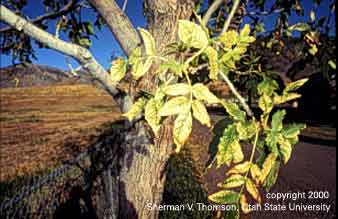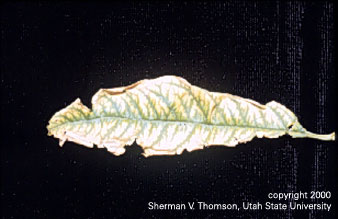Herbicide Injury
 Mulberry affected by phenoxy herbicide, showing characteristic leaf and petiole distortion. Leaves will normally curl upwards and the petiole will be twisted (epinastic).
Mulberry affected by phenoxy herbicide, showing characteristic leaf and petiole distortion. Leaves will normally curl upwards and the petiole will be twisted (epinastic).
 Ash tree with classic triazine damage. Plants affected by triazine will have foliage with interveinal chlorosis while main leaf veins remain green.
Ash tree with classic triazine damage. Plants affected by triazine will have foliage with interveinal chlorosis while main leaf veins remain green.
 Peach leaf with symptoms of triazine damage. Interveinal chlorosis and green main veins.
Peach leaf with symptoms of triazine damage. Interveinal chlorosis and green main veins.
Herbicide injury to plants can result from misuse or misapplication of herbicide used in yards and gardens. Damage from herbicide exposure can be extensive and is often permanent, resulting in the loss of valuable plants.
How Plants are Exposed to Herbicides:
1. Drift or Volatilization
With even the slightest breeze any herbicide applied as a liquid spray can drift onto nearby plants and cause damage. Some herbicides such as 2,4-D and dicamba may volatilize after application. These herbicides can evaporate for hours after application and move as an herbicide cloud onto other plants. Herbicide volatiles can be just as injurious as liquid sprays. Herbicides are most likely to volatilize when air temperatures are in excess of 80F.
2. Leaching or Run-off
Many herbicides are active in soil, which means that they can injure or kill susceptible plants whenever roots come into contact with the herbicide. Most injuries involving soil-active herbicides are the result of the chemical moving from the original site of application into the root zone of another plant. Movement occurs by leaching (water moving an herbicide through the soil), or by run-off of treated soil into an area where it is not wanted. Injury is often the result of both types of movement.
3. Misapplication
Using the wrong chemical, applying higher than the recommended rate, or improper timing of an herbicide can cause plant injury. Misapplication can also result from using a sprayer contaminated with small amounts of herbicide.
4. Contaminated Soil Amendments
Herbicide injury can occur when herbicide-contaminated material such as compost, mulch, soil, manure, or fertilizer is used around susceptible plants. Be sure to obtain these materials form a source known to be free of herbicides.
Typical Injury Symptoms from Common Herbicides:
Phenoxy Herbicides (2,4-D, dicamba, mecroprop, dandelion killer, etc)
Phenoxy herbicides and other growth regulators cause distortion and curling of foliar plant parts. Stems and leaf petioles are often twisted or bent, and leaves may be cupped. Abnormal growth is accompanied or followed by leaf yellowing (chlorosis) and browning (necrosis). Herbicides in this group typically injure the youngest tissues first. They affect most broadleaf plants, but symptoms are not normally produced on grasses.
Paraquat
Paraquat, Gramoxone and other contact herbicides cause rapid burning or necrosis of leaf and stem tissue. These herbicides only damage the plant tissue which they come into contact with. If spray coverage is thorough, the affected plant parts may be completely dead. If injury is the result of minor spray drift, affected plants may be dotted or speckled with necrotic tissue. Old and new tissue are affected equally, and both grasses and broadleaf plants are vulnerable.
Glyphosate (Roundup, Kleenup, etc.)
Glyphosate exposure causes yellowing, wilting, browning, and eventual death of foliage and plants. Damage usually appears first in new tissues, and the herbicide can translocate from one part of the plant to other susceptible tissues. Glyphosate may be stored over the winter in some plant tissues. Perennial plants such as lilac, honeysuckle, and poplar that are sprayed during the summer or fall may not have noticeable injury until the following season. This injury will appear as stunted, narrow, trap-like, and chlorotic leaves. Glyphosate affects both grass and broadleaf plants.
Soil-Applied Residual Herbicides (atrazine, simazine, etc.)
Soil sterilants are often used around driveways, fences, or sidewalks to stop all weed growth. They are also applied under new asphalt to prevent weeds from breaking through. These herbicides are persistent and very slow moving in the soil profile. Symptoms may not appear until years after the herbicide application. The first indication of injury is a mild yellowing or chlorosis around the margins and interveinal areas of leaves. Mild cases can resemble iron chlorosis and may be temporary. Severe injury can last for years and may eventually result in the death of the plant. Leaf chlorosis is followed by necrosis, and the leaf symptoms progress inward and down (toward the leaf base) on individual leaves, and from older to younger leaves on the same plant. Very young leaves may appear normal. Both grass and broadleaf plants are affected.
Corrective Measures:
Washing
If you suspect herbicide spray or drift is on your plants, wash the foliage thoroughly with water. Water dilutes the herbicide and washes it off the plant. Applying water soon after suspected herbicide exposure may minimize damage. Washing more than three or four hours after exposure may not give any control. This treatment does not apply to soil-active herbicides since water may move the chemical deeper into the root zone of the plants.
Inactivation Activated Charcoal
Most soil-active herbicides can be inactivated or absorbed by applying activated charcoal at a rate of 1 to 2 lbs. per 100 sq. ft. and incorporating it to a depth of 6 inches. Early treatment is essential to prevent the movement of herbicide deeper into the ground.
Root Pruning
If tree roots have grown into an area treated with a soil sterilant, a trench can be dug between the tree and the treated area. This cuts the roots and prevents further uptake of the soil sterilant. Damage to the tree from the herbicide will be prevented, but the water availability to the tree may also be reduced.
Soil or Dust
Glyphosate can be detoxified immediately by spreading dust or soil on exposed plant surfaces. Delays of even a few minutes may make this method ineffective.
Soil Replacement
In some cases, it may be necessary to completely remove the contaminated soil and replace it with clean soil. Be absolutely sure that the injury is the result of herbicide contaminated soil before resorting to this costly procedure.
Patience
If plants receive a sub-lethal dose of herbicide, they may show herbicide symptoms or injury for several seasons but may eventually recover. Rather than remove a large or valuable tree the first year damage shows, it is often wise to wait another season or two to see if the level of injury diminishes. If the tree seems to improve the following year, chances are good that it will recover.
Preventive Measures:
Although corrective measures work, it is far better to prevent herbicide exposure. Guidelines for prevention are as follows:
- Read and follow label directions on all chemicals. Use correct rates and apply as recommended. You should calibrate your sprayer before applying any herbicide.
- Do not mix two chemicals together unless they are compatible. If chemicals are combined, be sure they are mixed thoroughly in the sprayer before spraying.
- Never spray when it is windy. Any herbicide can drift due to the slightest breeze. Drift can be reduced by lowering sprayer pressure to produce coarse spray droplets.
- Keep spray boom or nozzles close to the ground and spray only the targeted area.
- When applying herbicides containing 2,4-D, use only the amine or the low volatile formulations and spray when air temperatures are below 80F.
- Do not apply soil-active herbicides where water run-off could carry the chemical to non-target plants.
- Homeowners should not use soil sterilants or long-term vegetation control chemicals.
- Never use your herbicide spray equipment to apply insecticides or fungicides.
- Know the source of soil, manure, etc. added to your garden. If it has been treated with a soil-active herbicide, do not use it.

